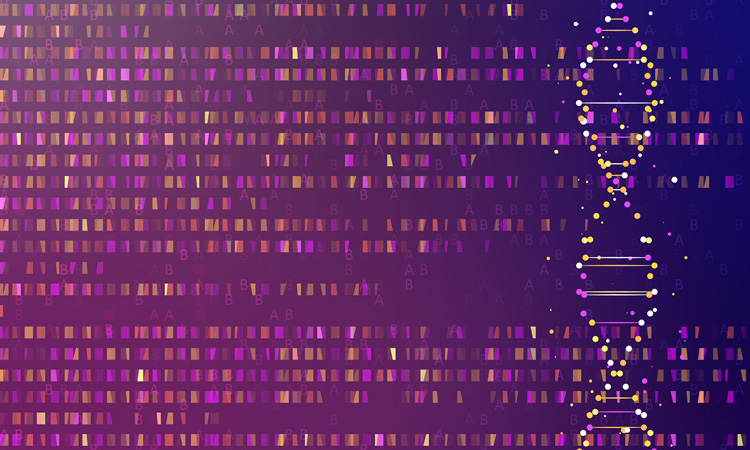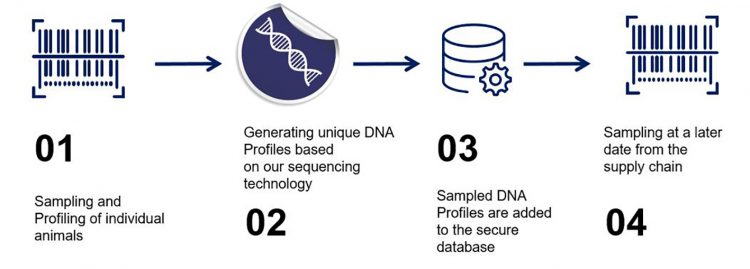Food testing 4.0
- Like
- Digg
- Del
- Tumblr
- VKontakte
- Buffer
- Love This
- Odnoklassniki
- Meneame
- Blogger
- Amazon
- Yahoo Mail
- Gmail
- AOL
- Newsvine
- HackerNews
- Evernote
- MySpace
- Mail.ru
- Viadeo
- Line
- Comments
- Yummly
- SMS
- Viber
- Telegram
- Subscribe
- Skype
- Facebook Messenger
- Kakao
- LiveJournal
- Yammer
- Edgar
- Fintel
- Mix
- Instapaper
- Copy Link
Posted: 4 September 2020 | Nina Constantine | No comments yet
As transparency becomes ever more important to consumers, Nina Constantine from Eurofins Genomics discusses the new frontiers in food safety and traceability.


Traceability, food fraud and food safety have never been more interlinked; we are seeing a growing demand from consumers for transparency on the provenance and safety of products.
As such, we are turning to Next Generation Sequencing (NGS) methods, combined with other emerging technologies, such as blockchain, in order to help respond faster, more accurately and more effectively than ever before.
NGS and food safety
Mapping contamination events is particularly important in preventing food recalls, which is one of the costliest and most brand damaging situations in the industry. By implementing a traceability programme, a company can prevent such events, while demonstrating their commitment to safety.
Utilising state-of-the-art NGS technology, we enable both public and private sector customers to identify, respond, and in the future, minimise harmful pathogen outbreaks and costly recall situations.
NGS, also known as high-throughput sequencing, is DNA sequencing technology that allows for the analysis of samples and systems at a level that was not possible before. NGS machines can sequence large sample numbers more cost-effectively than traditional methods and, in the process, also generate more detailed genomic information. One can use NGS machines to perform different kinds of analyses and methods, such as Whole Genome Sequencing (WGS).
WGS has been globally accepted as the most accurate high resolution subtyping technique, with demonstrated superior sensitivity and specificity compared to conventional methods. Using this technique on pathogenic bacterial strains provides unrivalled insight into their genetic relationship. This genomic information, combined with data such as the date and place of findings, can help track down the exact sources of contamination and therefore avoid large scale recalls.
What challenges can WGS help address?
The importance of WGS for food contamination monitoring is well known in the food industry. We have seen it being used for years by the Food and Drug Administration (FDA) in the US, and more recently witnessed a rise in its use by public health regulators across Europe too. Its use for outbreak response brings about significant benefits as it provides accurate information needed to contain outbreaks and further illnesses more quickly.
However, the applicability of WGS does not stop at public health monitoring. The discriminatory power of WGS has – and is – being applied to questions within the industry, such as:
- Is the contamination in my product coming from within my production facility?
- How are the contaminations found across my facility linked? Do they all come from one or multiple sources?
- Has cross contamination occurred between proficiency testing scheme (PTS) strains and the food/production isolates?
- What antimicrobial resistance and virulence factors are present within my strains?
- What strains have been found to be best in my products (for bio-production or probiotics for example)?
Given its ability to answer such a wide range of questions, WGS is definitely a powerful tool in microbiology and is one that is here to stay. Due to its use in both the public and private sectors, it is also one that should be at the top of agendas for organisations to understand its methodology and applicability.
Map it out
We have recently developed the DNA PathoTracker tool which helps organisations visualise their Whole Genome Sequencing results, and therefore, see where and how their contaminations or bacterial strains are linked. Additionally, the interactive tool maps out strains that may be linked across a production facility over time, which means one can see how a strain may have moved across a site.
NGS and traceability against food fraud
The biggest challenges facing the food and agribusiness industries globally are ensuring fraud and tampering of products is minimised, consumers trust that products are genuine, and companies have maximised their supply chain visibility.
We combine next generation technologies in the form of DNA traceability with blockchain-backed markers in order to encompass visibility in a supply chain with the highest precision possible. We combine the indisputability of DNA alongside the immutability of blockchain technology in order to address the challenges faced by the industry, as well as present new opportunities for marketing and for optimising supply chains.
DNA traceability – accurate and individual provenance
DNA traceability is based on using DNA as a target for tracking back the source of the product. DNA is present in each single cell and is unique to each individual. It also is highly stable against various processes and is therefore present throughout the whole beef supply chain. Due to these reasons, using DNA provides indisputable evidence of traceability and is a method that can trace a meat product back to every individual animal.
You can see an example process flow illustrated in Figure 1.


Figure 1 – Example process flow
Blockchain – effective marker and immutable data transfer
We offer our solution using the latest technologies to ensure the full traceability of products. This includes using blockchain technology to secure information being passed through the supply chain, and to offer end consumers an effective and easy‑to-scan marker on packages.
The collection of metadata from various sources enhances the traceability and the utilisation of this technology. The information that could be part of the marker includes, but is not limited to, the below:
- Certification under specific assurance programmes
- Source of the product (including DNA profile)
- Transit information such as temperature, humidity, and other logistics impacts
- Chain of custody throughout the supply chain
- The location of the product over time
- Expiry date and other ingredients list.
Our blockchain-backed markers therefore allow any party in the supply chain to identify all the necessary aspects of a product, contain that data, and then immutably transfer it onwards along the supply chain.
Blockchain technology in its most basic application provides the possibility to enhance traceability. However, the way in which it makes accessing information secure and easy also offers further opportunities, such as:
- It can be used to keep track of critical KPIs, and other relevant product attributes, such as shelf life or grade (quality). This would open up the opportunity for suppliers to improve the quality of their sourcing and therefore increase premiums based on freshness for example. Such attributes could also help reduce waste in the supply chain
- Capturing metadata on an easy-to-use platform can aid in pre-consignments approvals and enhance business intelligence through insights and opportunities for improvement.
DNA traceability and blockchain help address the following challenges:
1. Transparency
Consumer trust and loyalty is an increasingly challenging issue for businesses worldwide. Our full farm to fork solution is able to place back that trust into the ever complex supply chains, and assure customers that the products they are buying adhere to food safety, ethical, environmental and cultural practices. In fact, in a study conducted by Label Insight, they found that up to 75 percent of consumers do not currently trust the accuracy of food labels. Furthermore, nearly all of the respondents of the study (94 percent) said that it was important to them that brands and manufacturers are transparent about how their food is made.1 It is no longer enough to place a label on a package stating that products are sustainably produced – consumers want to know exactly how products are made and where they come from.
2. Food fraud and adulteration
The food supply chain is a complex network of distribution partners, producers, exporters, importers and retailers. DNA, unique to each individual animal, ensures that customers and partners along a supply chain can trust the source of their meat. It protects the farmers, exporters, importers, retailers and end consumers from the ever-existing issue of fraud.
3. Food safety
This kind of monitoring also ensures that in case of a food safety issue, food recalls can be done much more effectively given the targeted information stored is in blockchain.
Conclusion
We can definitely see a growing market trend for using genomics-based testing for food safety and traceability. NGS methods vary and can be extremely powerful based on the different kinds of samples and questions that need to be answered. We therefore know that NGS can enhance the confidence in the integrity of supply chains and in the safety of products, as well as promoting the value that traceability can represent to end customers. For more information, email [email protected].
Reference
About the author
Nina Constantine is the Director, Food & Environment at Eurofins Genomics and is responsible for developing innovative products and services to better enhance food safety and traceability. As part of her work, she launched DNA testing services for the hemp and cannabis markets at Eurofins Genomics. The services include strain authentication and microbial detection, as well as genotyping and breeding. Nina is also working on global projects for testing against COVID-19, as part of the global Eurofins Safer@Work programme.









